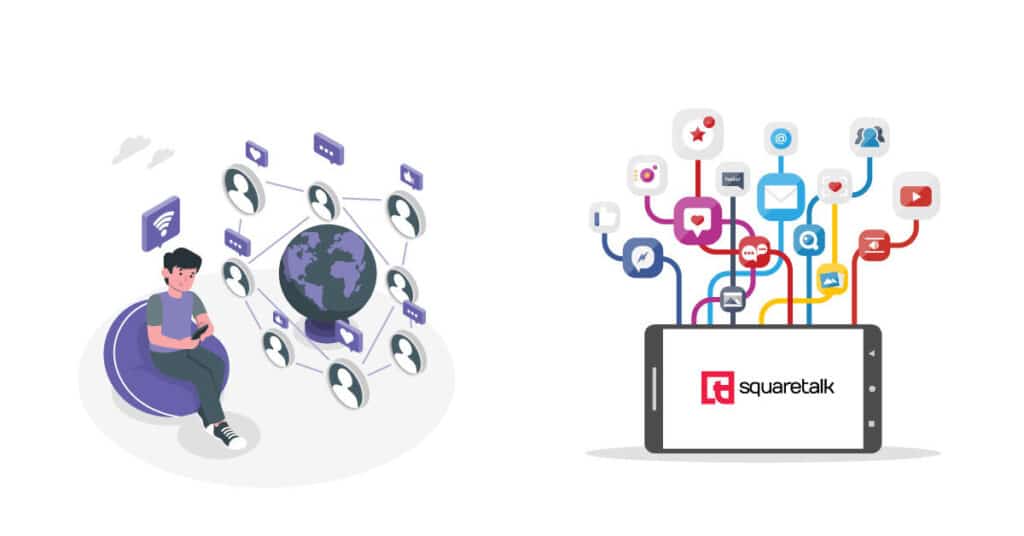Today’s customers engage with businesses through numerous channels – phone calls, website visits, social media interactions, and mobile app usage for browsing, purchasing, or support.
This evolution means that traditional sales strategies have to adapt.
Understanding different communication strategies, specifically multichannel and omnichannel approaches, is crucial because it impacts how you organize your sales efforts, interact with customers, and ultimately drive revenue.
In this guide, we’ll break down the two strategies, their key differences, and how embracing omnichannel communication can elevate your sales performance.
What is Multichannel Sales Communication?
A multichannel approach means using multiple customer touchpoints to reach prospects and customers, but each channel operates independently.
Multichannel can include :
- Social media
Multichannel communication is best for companies with straightforward sales funnels, smaller teams, or early-stage businesses testing multiple channels.
Advantages
- Easier Implementation : Businesses can begin with a single channel and deploy more over time without disrupting the already established ones. The quick implementation, lower initial investment, and distributed risk make a multichannel approach appealing to smaller companies or startups.
- Wider Audience Reach : You can meet prospects where they are, increasing brand visibility and sales opportunities. This flexibility can capture different customer segments who prefer one channel over another.
- Channel Specialization : Individual teams can hone their skills on a particular platform and create tailored sales strategies, scripts, and engagement models for each channel and lead profile. You can test new approaches within a single channel before widespread implementation, create separate performance benchmarks for sales reps, and allocate resources based on platform-specific ROI. Additionally, if a single channel fails, the loss can remain isolated and have a relatively minimal impact on overall sales operations.
Challenges
- Inconsistent Customer Experience : Siloed channels often produce inconsistent branding, tone of voice, or service level. Experiences and interaction frequency may vary from channel to channel. Prospects switching platforms might receive different messaging or have to restart conversations. This added friction increases customer effort and can lead to frustration and lower chances of a sale.
- Fragmented Data : Each channel’s data is stored separately, making it challenging to understand customer behavior or craft truly personalized interactions. Siloed analytics also mean missed cross-channel insights, a higher chance of duplicate or conflicting customer records, and inaccurate conversion attribution.
- Operational Inefficiency : Multichannel communication can lead to disorganization, wasted resources, and missed revenue opportunities. Running multiple independent channels can mean higher staffing requirements for separate teams and duplicate technology investments. Multiple agents can unknowingly contact the same prospect, disrupt their colleagues’ efforts across channels, or miss following up with a lead believing someone else is handling it.
What is Omnichannel Sales Communication?
An omnichannel approach uses all relevant channels in an integrated, cohesive way to sync data and conversation history and provide a seamless and personalized customer experience.
Omnichannel communication creates a unified customer journey across platforms, so interactions on your website, mobile app, social media, or call center all feel consistent for the customer and improve your efficiency.
Omnichannel communication is best for companies with high customer engagement needs, global sales teams, or businesses aiming for strong personalization.
Advantages
- Seamless Customer Experience : When all channels are integrated, customers effortlessly transition from one platform to another without repeating information or losing context, which boosts satisfaction and enhances sales opportunities. For example, a person may reach out via social media DM about a product and later call your sales phone number. The agent on the line will have access to the DM conversation and can continue the sale process. The prospect encounters the same core messaging, branding, and service quality on every channel.
- Personalized Interactions : A single view of customer data allows for individualized offers and conversations. Reps can recommend products based on holistic customer data or tailor solutions to past interactions.
- Unified Data Insights : Omnichannel’s centralized data approach provides a powerful analytic framework across the entire customer journey and makes KPI tracking more accurate. You can monitor how customers move among channels, from initial research to final purchase, enabling data-driven decision-making.
- Improved Efficiency and Productivity : Sales teams spend less time gathering information from different channels. Integrated Customer Relationship Management (CRM) systems and AI-driven analytics help reps focus on high-intent leads.
- Higher Revenue and Customer Lifetime Value : Harvard Business Review research shows that omnichannel customers spend 10% more online than those using a single channel. Pleasant experiences and context-aware selling increase trust and make people more likely to repeat purchasing or refer your brand to others. This positive loop can substantially boost revenue over time.
Challenges
- Complex Implementation : Integrating various technologies—like CRM, AI-driven analytics, chatbots, call tracking, and social media monitoring—can be time- and resource-intensive. Ensuring that each platform integrates seamlessly with the others demands careful planning and in most cases, IT support. Syncing data across platforms while ensuring security and data regulation compliance can also be a challenge.
- Significant Initial Investment : A true omnichannel environment often requires new or upgraded infrastructure, employee training, and ongoing technical maintenance.
- Organizational Shifts : Moving to omnichannel frequently involves breaking down silos, realigning teams, and fostering cross-department collaboration. Sales reps may feel overwhelmed managing too many touchpoints at once if you don’t prioritize the right channels.
Key Differences Between Multichannel and Omnichannel Communication for Sales
While both approaches involve multiple channels, there are fundamental differences in how those channels are managed and experienced.
Focus
Multichannel : The communication is channel- or product-centric. Each channel often has its own targets and strategies, not necessarily aligning with others.
Omnichannel : Every process is designed to meet the customer’s needs continuously and consistently in every channel.
Integration
- Multichannel : Channels are siloed, with little to no real-time syncing or data-sharing across departments. This makes comprehensive analytics difficult. Each channel holds its records, which rarely integrate. This approach requires channel-specific tools, less complex data requirements, and more manual management.
- Omnichannel : Channels are interconnected, share a unified database, and provide a seamless flow of information. This allows for better attribution of sales efforts, identification of optimal conversion paths, and more accurate forecasting based on complete data. Omnichannel communication requires an integrated CRM as a central hub for all interactions, sophisticated data management, and real-time synchronization.
Complexity
- Multichannel : It’s easier and faster to launch, requires separate tools without complicated integrations, and takes less training.
- Omnichannel : Requires higher integration, more advanced agent training, and automation to connect all channels into a seamless, customer-first experience.
Customer Loyalty and Satisfaction
- Multichannel : Customers can engage through their preferred channels which are typically optimized for specific audiences and offer richer, platform-appropriate engagement formats and loyalty incentives. When switching channels, however, customer satisfaction often drops drastically and can lead to higher churn rates.
- Omnichannel : A smooth, personalized journey and unified loyalty programs increase trust and repeat business. In fact, companies with strong omnichannel strategies retain an average of 89% of their customers, compared to only 33% for companies with weak omnichannel engagement.
Impact on Sales Teams
The choice between multichannel and omnichannel communication doesn’t just affect customers; it also deeply influences how your sales team operates. Here’s how each approach impacts sales organizations :
Organizational Structure
- Multichannel : Teams are typically channel-specific, with clear and independent responsibilities, metrics, and reporting structures. This can result in a lack of cross-channel collaboration and manual transfer of leads between teams.
- Omnichannel : Often involves cross-trained agents working simultaneously on multiple channels. Teams share a single customer data platform, allowing for real-time collaboration and faster response times.
Sales Processes and Workflow
- Multichannel : Each channel has its own lead scoring and prioritization, scripts, follow-up tactics, and management. Transitioning leads between platforms often requires manual coordination, which can delay responses and complicate the overall sales process by requiring additional steps to ensure data consistency. Multichannel communication works for simple outbound sales but isn’t ideal for high-touch processes.
- Omnichannel : All channels share a unified sales process and progress stages. The holistic view of leads and interactions allows for centralized lead management, standardized lead qualification, and scoring criteria adapted to the channel context. This integrated workflow streamlines handoffs and follow-ups, minimizes information loss during channel transitions, reduces duplicate agent effort, and ensures comprehensive records across all touchpoints.
Sale Cycles
- Multichannel : Initial outreach can be swift across several channels, but inconsistent data management, information gaps, and varying response times often slow progression. Repetitive or disjointed touchpoints prolong the middle stages of the sales funnel, potentially causing prospects to lose momentum or interest. Without a complete interaction history, sales teams may misinterpret cycle stages or use channel-specific closing techniques that don’t align with prior conversations. For example, a person negotiates a specific discount via phone, but when they try to complete the purchase online, that pricing isn’t reflected. When they reach out via chat, the agent offers a different promotion entirely, creating confusion and eroding trust.
- Omnichannel : Omnichannel sales cycles flow more seamlessly as reps track customer interactions in real time. This unified data view enables them to make more informed decisions, personalize interactions, and tailor strategies to improve conversion rates. Buyers rarely repeat themselves or experience conversation interruptions when switching platforms, boosting trust and confidence. Omnichannel tracks engagement patterns, adapts accordingly, and determines which channel a prospect is most responsive to (e.g., some leads prefer WhatsApp over the phone). This streamlined process often closes deals faster, reduces the risk of stalled opportunities, and allows sales reps to focus on high-value interactions instead of administrative tasks.
Operational Scalability
- Multichannel : Expanding one platform at a time based on performance can cause minimal disruption due to the lower technical complexity and initial training investment per new hire. Diversified sales channels reduce dependency on any single platform, which provides resilience against disruptions or changes in market conditions. However, managing multiple standalone systems and scaling can be complex, potentially leading to data fragmentation, inconsistent service standards, and higher long-term costs for staff and resources.
- Omnichannel : Omnichannel scalability requires significant tech setup but yields benefits over time. Centralized data and processes let businesses rapidly add channels or accommodate fluctuating demand across platforms. Adding more leads does not require proportional hiring. Omnichannel communication needs more complex initial training but results in greater staff flexibility and efficient resource allocation as your organization grows. The unified approach streamlines expansion, reduces overhead, and supports consistent brand and customer experiences.
Relationship Management
- Multichannel : Cold outreach via multiple channels increases the chances of a response and attracting new leads, while channel diversification provides accessibility and convenience to prospects. However, relationship-building can suffer if customers have to reintroduce themselves every time they switch to another channel. The engagement rates are typically lower, leading to weaker long-term connections.
Omnichannel : When customers don’t have to start from scratch every time they engage with your brand on a new channel, it builds trust faster, creates stronger rapport based on past conversations, and long-term engagements.
Best Practices for Adopting an Omnichannel Sales Strategy
If you’re ready to move toward omnichannel communication, here are some best practices to ensure a smooth transition and effective implementation :
Map and Understand Customer Journeys
Start by walking in your customers’ shoes. Identify the typical paths customers take when interacting with your business.
Track touchpoints from initial interest to conversion and post-sale interactions.
Mapping out these journeys will highlight the most important channels and how customers hop between them. This understanding is crucial for designing an omnichannel experience that meets customer needs at each step.
Integrate Channels Gradually
You don’t need to connect every channel at once. Identify pain points and divides between channels so you can prioritize integrations based on the highest-impact touchpoints.
This phased rollout helps isolate and fix issues on a smaller scale, minimizing broader disruption. Gathering customer feedback on their cross-channel experiences will help you optimize the process.
Invest in Unified Technology and CRM
Evaluate your current software and identify what needs to be upgraded or consolidated. Investing in a good CRM and call center software will allow all channels to pull from the same customer data in real-time and be managed in one platform.
You can also use different CCaaS tools and functionalities to align omnichannel communication. Call routing and IVR systems, for example, can collect initial information before transferring the conversation to live agents and create smoother transitions between automated and human assistance. Chatbots and virtual assistants can personalize follow-ups via email, message apps, or SMS, while automated triggers can initiate actions based on engagement (e.g., if a prospect sends a product information request on WhatsApp but doesn’t buy or see a demo, the system schedules a phone call for a sales rep).
Break Down Organizational Silos
Technology alone won’t create an omnichannel culture. Encourage and foster cross-team collaboration.
Set omnichannel goals (like reducing variation in customer satisfaction scores across channels by at least 80%, for example) that everyone works toward, rather than channel-specific goals that may conflict. By breaking down silos, you ensure the whole organization is aligned around the customer experience.
Maintain Consistent Branding and Messaging
Align your visual identity, tone, promotional offers, and channel-appropriate versions of core messages.
Draft brand guidelines that everyone follows. This consistency builds trust: customers see a unified brand instead of a disjointed sales approach.
Leverage Unified Data for Personalization and Decisions
Once your channels are integrated, you can segment customers more accurately, track multi-platform behavior, and deliver tailored recommendations.
Use analytics to determine which channels drive the most conversions and how each channel influences others (e.g., a social media message and an email worm up a lead, even if they don’t close the deal before you reach out by phone). Combine these insights with customer data to deliver tailored content, pitches, or recommendations across platforms and move prospects down the sales funnel faster.
Keep refining your approach by analyzing cross-channel metrics, identifying patterns, and personalizing interactions whenever possible.
Continuously Test, Learn, and Refine
Omnichannel is not a one-time setup. Monitor metrics, like lead conversion rates and average response times per channel, to see if your integrated approach is performing as intended.
Experiment with new processes and conduct A/B tests to discover what performs best. If data shows high engagement on a specific channel (e.g., WhatsApp or phone), double down on those efforts and drop or optimize underperforming channels to focus resources on high-impact touchpoints.
Regularly share insights with your entire team to keep everyone engaged in ongoing improvements.
Conclusion
Both multichannel and omnichannel sales strategies offer tangible benefits, but they cater to different organizational needs. Multichannel setups can be ideal for startups or smaller teams looking for lower-cost, straightforward deployment where separate channels provide targeted outreach.
However, as your customer base and communication demands grow, siloed channel management risks inefficiency and inconsistent customer experiences.
This is where omnichannel excels—unifying data, interactions, and branding to create cohesive journeys that boost loyalty and lifetime value.
Before deciding whether to adopt a multichannel or omnichannel approach, it’s important to evaluate your current sales operation, business goals, technology infrastructure, customer expectations, and scalability plans.
This assessment will help clarify which approach better aligns with your current needs and growth aspirations. The best sales communication strategy is the one that meets your customers where they are today while setting your team up for success tomorrow.
FAQ
What is the difference between multichannel and omnichannel sales strategies?
A: Multichannel strategies use independent channels (e.g., email, social media) with siloed data, making them easier to launch but less cohesive. Omnichannel integrates all channels for a unified experience, using a shared database and real-time syncing, requiring advanced CRM and data management.
How does an omnichannel approach enhance customer loyalty and satisfaction?
A: Omnichannel ensures seamless experiences, eliminating the need for customers to repeat information. Personalized interactions via unified data boost satisfaction. Studies show omnichannel retains 89% of customers versus 33% for weak strategies, with 10% higher online spending.
What are the operational challenges of implementing an omnichannel strategy?
A: Silos, fragmented IDs and legacy IVRs can stall a rollout. Data governance must resolve duplicate profiles while change management trains agents in channel-blended conversations.
How can sales teams transition from a multichannel to an omnichannel approach?
A: Start by issuing one customer-ID across systems, then layer a CDP or contact-centre platform (Squaretalk, Genesys Cloud) to orchestrate routing and pull all interactions into a shared view. Pilot with two channels, measure CSAT and AHT deltas, then expand.
What tools or platforms can support the integration of omnichannel communication?
A: Several tools facilitate omnichannel integration, including:
- CRM Systems: Manage customer data and interactions.
- Marketing Automation Platforms: Automate and personalize marketing efforts.
- Customer Support Software: Provide consistent support across channels.
- Analytics Tools: Track and analyze customer behavior and engagement.








